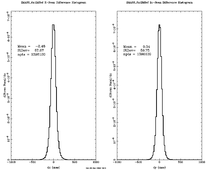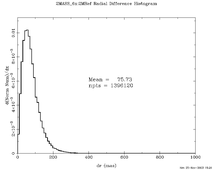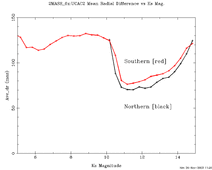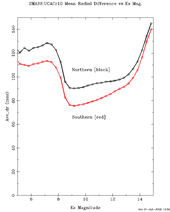

2MASS 6x positions and uncertainties are evaluated via comparison to various reference catalogs. Position reconstruction for 6x processing differed from the All-Sky Catalog processing in several ways as described in A3.5.b. The most important difference was that a subset of the 2MASS All-Sky Point Source Catalog (PSC), rather than the Tycho-2 Catalog, was used as the astrometric reference catalog for the 6x processing. This subset is referred to as the 2MASS Reference Catalog (2MREF) and was selected to provide the best all-sky astrometry, while retaining high reference star density. In addition to the 2MREF catalog, comparisons are also made to the Tycho-2 catalog with stars originally in Tycho-1, hereafter referred to as Tycho-2(1), and those new to Tycho-2, referred to as Tycho-2(2). The Tycho catalog comparison is done in two parts because of the significant difference in astrometric quality between the two subsets of the Tycho-2 Catalog. Finally, comparisons are made to the UCAC2 version of the U.S. Naval Observatory CCD Astrographic Catalog. UCAC2 has improvements over the previous UCACr10 version, including, among other things, extension to regions further north and the inclusion of proper motion information. However, proper motions were not used in this analysis. More extensive comparisons are made to the UCAC2, since it believed to be the best external measure for astrometry.
i. Global Statistics
Global comparisons of the 6x positions with the 2MREF catalog show very good agreement. Biases are quite small (-2.48 mas cross-scan and 0.34 mas in-scan) and population uncertainties are tight (67.67 mas cross-scan and 59.75 mas in-scan). The mean radial difference is just 75.73 mas. These statistics are shown in Figures 1 and 2.

| 
|
| Figure 1 - 2MASS 6x vs. 2MREF cross-scan (left) and in-scan (right) position difference histograms | Figure 2 - 2MASS 6x vs. 2MREF radial position difference histogram |
Global comparisons with the Tycho-2 Catalog (Figures 3 and 5) are slightly worse than the same comparisons made between the All-Sky PSC positions and Tycho-2 (Figures 4 and 6). The mean radial difference has increased from 100 and 161 mas for Tycho-2(1) and Tycho-2(2), respectively, to 124 and 178 mas. This is a 24% increase with respect to Tycho-2(1) and an 11% increase with respect to Tycho-2(2). The key here is that 2MASS sources matched to Tycho-2(2) are, on average, about 1.5 magnitudes fainter than those matched to Tycho-2(1). As will be seen in the section on "Variation with Magnitude" the transition between READ1 and READ_2 has shifted to a Ks-band magnitude of ~10.5, making almost all Tycho-2(1) matches and many more Tycho-2(2) matches READ1 sources in the 6x processing. Since the READ1 extracted positions are less accurate, the Tycho-2 residuals are greater. This magnitude difference in the READ1/READ2 transition is, in fact, the reason Tycho-2 was not used as the reference catalog for 6x processing.
It is interesting to note that the global 2MASS_6x:UCAC2 differences (Figures 7 and 9) are very similar to the 2MASS All-Sky PSC:UCACr10 differences (Figures 8 and 10). In fact, the mean radial differences are within 1 mas (94 mas for the All-Sky PSC and 95 mas for the 6x-PSC). This indicates that overall 6x position quality is about as good as the 2MASS Main Survey.
The quoted position uncertainties resulting from the 6x processing (Figure 11) and the main survey processing (Figure 12), however, are not consistent with the above conclusion. The mean quoted uncertainties have increased, for cross-scan and in-scan, from 64 and 67 mas, respectively, for the survey to 79 and 89 mas, respectively, for 6x.
The global mean  2 values show that
the 6x values (Figure 13)
are too low (0.78 for cross-scan, 0.82 for in-scan),
while the All-Sky PSC values (Figure 14)
were too high (1.16 cross-scan, 1.19 in-scan).
This tells us that the 6x uncertainties
are, on average, too conservative, and the All-Sky PSC uncertainties were not
conservative enough. It will be seen in A3.2.c.iii below
that this is an oversimplification, and that the uncertainty issues are
strongly dependent on magnitude.
2 values show that
the 6x values (Figure 13)
are too low (0.78 for cross-scan, 0.82 for in-scan),
while the All-Sky PSC values (Figure 14)
were too high (1.16 cross-scan, 1.19 in-scan).
This tells us that the 6x uncertainties
are, on average, too conservative, and the All-Sky PSC uncertainties were not
conservative enough. It will be seen in A3.2.c.iii below
that this is an oversimplification, and that the uncertainty issues are
strongly dependent on magnitude.
ii. Variation with Cross-Scan Position
Astrometric accuracy variations with cross-scan position
are examined here as a function of 2MASS facility and
for READ1 and READ2 sources separately.
Cross-scan variations are affected primarily by distortion in the
2MASS cameras, which differ between the northern and southern observatories.
Distortion for READ1 and READ2 source extractions is corrected at
different steps in the pipeline data reduction.
Figures 15 and
16 show 2MASS/UCAC position
residuals as a function of cross-scan position for the 6x and
All-Sky PSC 2MASS positions, respectively. The agreement between
the READ1 and READ2 residuals for the 6x position shown in Figure 15
illustrates that the
READ1
distortion noted in the main survey processing has been corrected
in the southern 6x position reconstruction. There are too few
READ1 stars extracted from the northern 6x observations that
overlap the available UCAC2 to confirm the correction for the northern
data. However, the same code was used to process 6x data from both
observatories.
The marked increase in radial position error at
the scan edges seen in the All-Sky PSC (Figure 18)
is no longer present in the 6x results (Figure 17).
The 6x  2 values stay relatively flat
across the scan, as well (Figures 19 and
20).
2 values stay relatively flat
across the scan, as well (Figures 19 and
20).
Figures 21 and 22 show the 2MASS:UCAC RMS position residuals as a function cross-scan and in-scan positions. The RMS values shown in these figures are derived by subtracting in quadrature the quoted UCAC uncertainties from the 2MASS:UCAC rms values computed for each cross-scan and in-scan bin. If the UCAC uncertainties were perfectly characterized, then this would provide a true measure of 2MASS errors as a function of scan position. The dashed lines Figures 21 and 22 indicate the quoted 2MASS uncertainties on each axis as a comparison to the derived 2MASS:UCAC RMS values.
iii. Variation with Magnitude
The distribution of 2MASS magnitudes for sources matched to UCAC remains
essentially unchanged between the main survey
(Figure 24) and 6x data
(Figure 23), because the
UCAC catalog limit had already been reached with the All-Sky observations.
The mean cross-scan and in-scan position differences plotted vs.
2MASS Ks-band magnitude in Figures
25
and 26
show that the 6x systematic errors are comparable to, if not slightly
better than those for the All-Sky PSC.
In particular, the READ1:READ2
transition is less noticeable.
The mean radial difference between 2MASS and UCAC positions are plotted vs. Ks magnitude in Figures 27 and 28. For the southern 2MASS 6x data, the residuals are slightly larger than All-Sky PSC in the READ1 brightness regime, and about the same in the READ2-READ1 regime. The northern facility data (only available for READ2-READ1) shows the 6x residuals to be better than those of the All-Sky PSC. An important point to note in these figures is the shift in the READ1:READ2-READ1 transition point from ~8.5 mag for All-Sky PSC down to ~10.5 mag for 6x. As can be seen from these figures, 6x sources in the transition region are likely to have larger positional errors than the same All-Sky PSC sources.

| 
|
| Figure 27 - Mean 2MASS 6x:UCAC2 radial position differences as a function of Ks magnitude | Figure 28 - Mean 2MASS All-Sky PSC:UCACr10 radial position differences as a function of Ks magnitude |
Aside from the previously discussed shift in the READ1:READ2-READ1
transition
point, the shape of the mean  2
vs. magnitude relation is quite similar for 6x and All-Sky PSC positions
as shown in Figure 29 and
(Figure 30.
The underestimate of the READ1 errors in both cases likely results from
band-to-band correlations unaccounted for in the extraction
uncertainties. The increase at the faint end is also driven by errors in the
extraction uncertainties assigned. The fact that the 6x
2
vs. magnitude relation is quite similar for 6x and All-Sky PSC positions
as shown in Figure 29 and
(Figure 30.
The underestimate of the READ1 errors in both cases likely results from
band-to-band correlations unaccounted for in the extraction
uncertainties. The increase at the faint end is also driven by errors in the
extraction uncertainties assigned. The fact that the 6x
 2 values drop so low during most of the
READ2 region for 6x, but not for All-Sky PSC, is almost certainly due to an
overly conservative estimate of 2MREF correlated errors as a function of scan
position.
Figures 31 and
32 compare the derived 2MASS:UCAC
position residual RMS values (black line) corrected for
UCAC uncertainties and the quoted 2MASS position uncertainties (red line)
as a function of brightness for the 6x and All-Sky PSC.
2 values drop so low during most of the
READ2 region for 6x, but not for All-Sky PSC, is almost certainly due to an
overly conservative estimate of 2MREF correlated errors as a function of scan
position.
Figures 31 and
32 compare the derived 2MASS:UCAC
position residual RMS values (black line) corrected for
UCAC uncertainties and the quoted 2MASS position uncertainties (red line)
as a function of brightness for the 6x and All-Sky PSC.
iv. Summary
[Last Updated: 2007 January 7; by H. McCallon and R. Cutri]